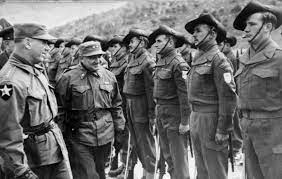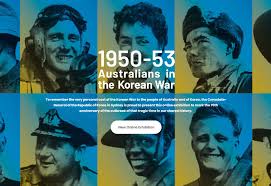Although the Regiment, has significant Battle Honours from its beginnings under the 65th, 66th and 67th Australian Infantry Battalions, this was the first as The Royal Australian Regiment. 17,000 Australian from Navy, Army and RAAF were committed to the war, of these 340 died, over 1,200 wound and 30 became POW’s, there are still approximately 40 still listed as missing in action
The men who gave the Supreme Sacrifice are remembered on many memorials around the country including the Australian War Memorial and the National Korean Memorial however a most significant Memorial is our own RAR National Memorial Walk, “The Spiritual Home” of the Regiment https://www.rarnationalmemorialwalk.org.au/, where the flag will be flown at half master tomorrow. Take a moment tomorrow to reflect for those who have come before us, “ Lest we Forget”

Photo: General Van Fleet, General Officer Commanding, 8th US Army (far left) inspects members of the 3rd Battalion (3 RAR), when bestowing the Presidential citation in recognition of the Unit’s action at Kapyong, Korea. US Major General John W O’Daniel is to Van Fleet’s left. [AWM 083857]
On 27 July each year, we commemorate Korean Veterans’ Day. This is the anniversary of the day in 1953 when an armistice was signed to end the fighting in Korea. This day is a time for us to remember the almost 18,000 Australians who served in the war, including some 340 who lost their lives.
The Korean War began on 25 June 1950 when the Korean People’s Army of North Korea invaded South Korea. The North Koreans captured South Korea’s capital, Seoul, within days.
The United Nations Security Council declared North Korea the aggressor and set up the United Nations Command, a joint force to support South Korea.
Australia was one of 21 members of the United Nations to send military forces to help South Korea.
The Korean War became one of the most destructive conflicts of the modern era. Many of Korea’s major cities were affected. The death toll rose to approximately 3 million, including many civilians.
Fighting formally ended on 27 July 1953 when an armistice was signed by officials from the United States, North Korea and China.
Some Australian defence personnel remained in Korea until 1957. They served as part of a multinational peacekeeping force in the post-armistice period.
The Korean War is sometimes referred to as the ‘forgotten war’ because it occurred between two very high-profile conflicts, World War II and the Vietnam War.
Australia at war
Each of Australia’s three defence services was involved in the Korean War. It was the first war for the newly formed Australian Regular Army.
Korea was the first and only time an aircraft carrier of the Royal Australian Navy had conducted wartime operations.
It was also the last time the Royal Australian Air Force engaged in air-to-air combat.

Of almost 18,000 Navy, Army and Air Force personnel who served in Korea, 340 lost their lives, over 1216 were wounded, and 29 became prisoners of war (POWs).
More than 150 Australian nursing sisters served both in Korea and Japan during the war. They treated the wounded and sick in hospitals, aboard hospital trains and on aeromedical evacuation flights.
In Australia, there was little political or community opposition to our involvement in the Korean War. Very few Australians opposed the Australian Government’s military commitment.
Australia’s involvement in Korea reaffirmed a view, formed after Japan entered World War II, that Australia’s security interests now lay within Asia and our region.
The war also formalised Australia’s military alliance with the United States in the ANZUS Treaty.
